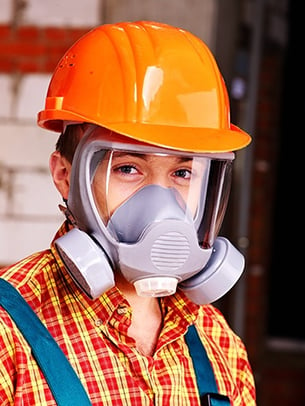A farm—like any other industrial workplace—has its fair share of respiratory hazards that place employees at risk. Some agriculture safety hazards, primarily when transferring or mixing chemicals, involve exposure to dangerous gases, while others, such as grain bins, feed mills, livestock areas or confined spaces with poor ventilation, represent hazards that can naturally cause serious breathing difficulties.
 So what are your options when it comes to respiratory-protection equipment?
So what are your options when it comes to respiratory-protection equipment?
Each respiratory protection device is designed differently for a specific reason. Making sure you have the right device for the task at hand is important.
For example, some equipment is less sophisticated, but effectively designed for filtering dust and other particles in the air that can be harmful at high concentrations. See the photograph to the left. This loose-fitting, full-face piece is quite different from the familiar N95 Filtering face piece—known more commonly as a dust mask.
Another option for dusty applications and to provide protection when exposed to vapors or fumes that are not immediately dangerous to life or health are various cartridge-filtered or “air-purifying” respirators:
- Air-purifying respirator
- Negative-pressure respirator
- Positive-pressure respirator
- Pressure-demand respirator
- Escape-only respirator
Some respiratory protection equipment, such as an “escape only” respirator, should be on hand in an emergency and used only as a temporary means to get clear of, say, a chemical spill. Of course, some chemicals and other agents represent more of an immediate threat. These types of work environments require “supplied-air” systems, such as:
- Supplied-air respirator
- Self-contained breathing apparatus
As the term indicates, these respirators are connected to pumps or tanks that provide an air supply that is uncontaminated by the surrounding conditions.
In any event, you should carefully evaluate the work ahead of you, as well as the equipment on hand, reading labels and equipment ratings to ensure you have the right protection for the job—and your respiratory system.


 So what are your options when it comes to
So what are your options when it comes to 

